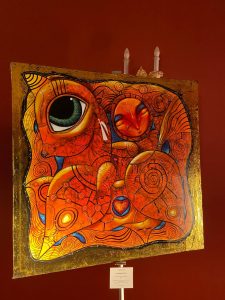
Paper unicorn
Vol. 25, Issue 13, 20 January 2023
Painting can become a new and interesting hobby, and not only in the form of a simple collection of paintings, but a person can also try drawing, which can contribute to:
-Development of emotional intelligence and a way of psychological relaxation
-Self-education and self-esteem improvement
-Expanding horizons and developing imagination.
Each painting was created by the author to achieve a specific goal. In ancient times, when literacy was a privilege of the upper class, paintings were used to educate a large mass of people. For example, in the era of early Christianity, the church sought to spread evangelical teaching as widely as possible. This is how icons and illustrations for the Bible appeared. People looked at the drawing and compared its contents with the words of the preachers. Later, with a noticeable increase in the number of literate people, artists got tired of making information available to those who cannot read. Painters have learned to encode secret messages in canvases, sometimes laying tasks in them that is impossible even for an enlightened viewer.
Even the most truthful and accurate photo to the smallest detail is not able to convey to the viewer the emotional state and the message of the author. But the painting, even if it is made in abstractionism or cubism, contains a coded message. And happy is the one who can at least partially reveal the artist’s intentions, absorb his mood, and decipher the information embedded in the work.
On vacation in January, I visited an art gallery in which I was very interested in one painting. Let’s start with a little story about the author to understand a little about his work. Valery Nikolaevich Ivanov (creative pseudonym Valerius, b. June 13, 1968, Sibai, Bashkiria) — contemporary artist, performer, and book illustrator.
The artist’s works are in 12 Western galleries and many private collections in Russia, the USA, France, and Sweden., including the Royal Collection and in the collections of Santa Claus (Finland). Art critics define Valery Ivanov’s style as ethno-infance. In 2005, a postage stamp dedicated to the work of Valerius was issued in the Netherlands.
The picture I chose is called “Unicorn”.

Now we will think about the symbolism. Unicorn is one of the very few mythological creatures that are considered useful in almost all traditions. In the modern sense, it’s just a mysterious beautiful horse with one horn. Unicorns occupy an honorable place in Greek mythology, Chinese traditions, and the art of the Indus Valley and India. Greek writers, including Pliny the Elder and Aristotle, mention them in their writings. In addition, the unicorn is a symbol of magic. His magical powers are also legendary. Its horn is harder than the most durable diamond, it can neutralize poisons. And unicorn tears can heal both physical wounds and sorrows of the heart. Some of them can fly and talk to all kinds of other living creatures. The magical unicorn is a symbol of freedom, healing, and beauty. The author could portray the Unicorn as a fantastic creature from another world, whose appearance portends happiness or is depicted as a talisman, faith in spiritual purity.
It is certainly difficult to determine what feelings and emotions the author experienced during the creation of the masterpiece. Everyone sees in this picture something of their own, mysterious, or strange, but special in their way.
And what do you see?
- New Year’s mood - 22nd November 2024
- Minimalism is a way of life. Where to begin? - 15th November 2024
- Why do you need an air humidifier? - 8th November 2024
